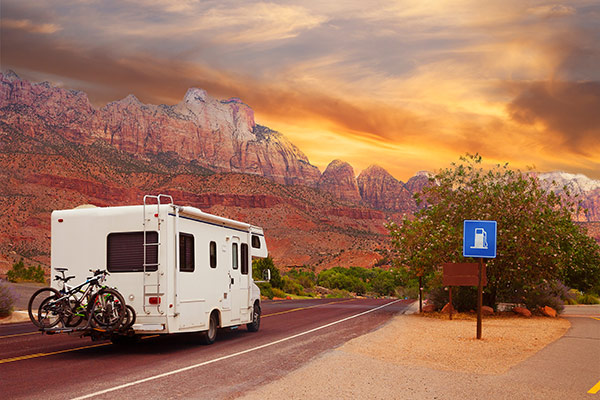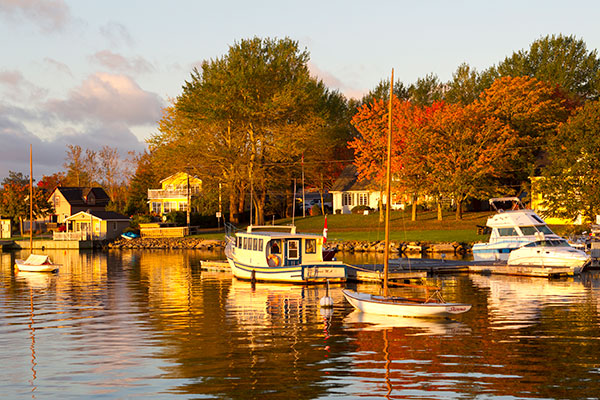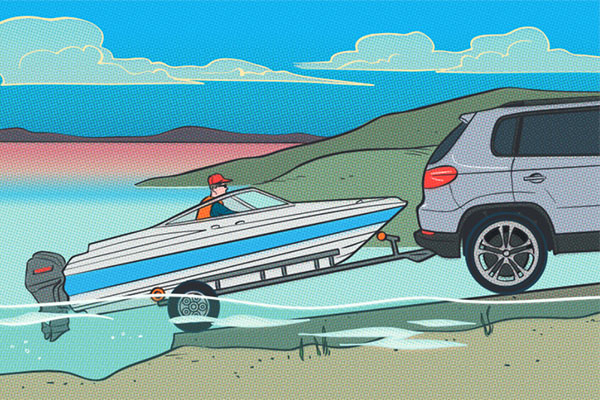Summer means the start of RV season, with places to explore and fun times to be had! With gas prices in mind, you’ll want to be conscious of your fuel consumption. Fortunately, there are a few easy ways to increase your RV’s fuel efficiency and save money on gas, says Mark Polk of RV Education 101 and an RV expert for Kampgrounds of America (KOA).
Here are eight strategies Polk recommends to help ease pain at the pump.
1. Maintain Your Ride
Before you hit the road for the first time this season, do a maintenance check. “When an RV is in storage, batteries lose their charge, tires lose air pressure, seams and sealants need to be inspected and all the systems on the RV need to be checked for proper operation,” Polk says. If you don’t feel comfortable inspecting your own RV, take it to a pro. Also, check the air filters at least every six months and replace them if they’re dirty. Dirty or clogged filters can trigger the engine’s computer to compensate by increasing the amount of fuel injected into the cylinders.
2. Lighten Your Load
“Anything you can do to decrease weight helps,” Polk says. “In fact, making several small changes can lessen your load by hundreds of pounds.” For example, only take the amount of fresh water you need to get to your destination, refill the tank as needed when you arrive and empty the water tank back down to the trip minimum before driving off. Stock up on heavy supplies like firewood on-site. Also, if there’s something in your RV that you haven’t used in the last six months, get rid of it—you probably don’t need it.
3. Check Your Tire Pressure Regularly
Underinflated tires can have a negative effect on fuel consumption. Check your tire pressure before you leave (and periodically during the trip—especially after dramatic shifts in elevation or temperature) to make sure it matches your manufacturer’s recommendation. “For every one percent your tires are under the recommended inflation pressure, your fuel efficiency can decrease by 3 percent,” Polk says.
4. Stay Balanced
Uneven weight distribution can make your vehicle sway and negatively impact how it handles. Try to keep heavier objects closer to the floor of the vehicle and balance out the load in the front, rear and sides. Not only will this save gas, but it also helps make for a safer drive.
5. Cool It With The A/C
Only use the dash air-conditioner when absolutely necessary. “Using the dash air on the maximum setting reduces fuel efficiency by 5 to 25 percent,” Polk says. “That’s pretty significant.”
6. Drive Smoother
Dramatic accelerations and fast driving can quickly drain your tank. Keeping your speed steady and taking it easy coming out of stops can help. “Speeding and rapid acceleration lowers gas mileage by 15 to 30 percent,” Polk says. “If you can maintain a constant speed, around 55 to 60 miles per hour, you’ll increase your fuel efficiency.” When possible and safe to do so, use overdrive and cruise control to help drive at a constant—and efficient—speed.
7. Map Your Route
Run your prospective destinations through a gas-mileage calculator to estimate the cost of getting there. Then log into GEICO’s gas station locator before you leave to pinpoint the best deals along your route, or access it on the go from the GEICO Mobile app.
8. Camp Closer, Stay Longer
RVers can enjoy a great outdoor experience without needing to drive too far, thanks to more than 16,000 RV parks and campgrounds nationwide (and almost 500 KOAs throughout North America). Once you get to your local campsite, opt to stay an extra night or two instead of rushing to your next destination. After all, many RV parks are vacation destinations in their own right; plus, they may offer lower rates for longer stays.
Want to cut the cost of RV ownership even more? Find out how much cash you could stash with RV insurance from GEICO. Get a fast, free quote now!
Read more: How To Avoid Common RV Problems
By Maridel Reyes










Leave a comment